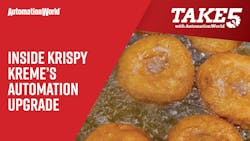Quick hits:
- How Krispy Kreme upgraded its equipment automation using the SD cards in its legacy drives.
- The retrofit kit developed for this upgrade enables the upgrade to be performed by someone familiar with the equipment, but not requiring any specific automation or controls expertise.
- The upgrades have improved accuracy of doughnut frying time by 12%, while reducing motor amperage by almost 17 percent and motor temperatures by 34 percent.
- Using Siemens TIA portal, ThinkPLC can access any of the Siemens G-120 drives remotely to debug problems, assess faults, and trend data.
Welcome to Take Five with Automation World. I’m David Greenfield, Director of Content, and in this episode we’ll be looking at how Krispy Kreme is modernizing its production machinery to save costs, improve worker safety, and enable remote monitoring of its equipment.
To start, it’s important to realize that Krispy Kreme is not just a doughnut maker, it also manufactures the equipment used in its store to make the doughnuts. In fact, the company’s headquarters in North Carolina features a manufacturing facility that houses research, design, testing, engineering, and production operations.
The machines and processing equipment built there use Siemens drives and controls, integrated by ThinkPLC, the automation engineering consultant to Krispy Kreme.
Bobby Cole, president of ThinkPLC, says the doughnut making process at Krispy Kreme requires very precise controls to keep the shortening the doughnuts are fried in within an exact temperature range and then move them through a specific cooling process.
Recently, Krispy Kreme has been updating its manufacturing operations to increase machine uptime and mean time before failure. To enable consistent automation upgrades across Krispy Kreme’s more than 600 locations worldwide, ThinkPLC was tasked with figuring out the fastest and most cost-efficient way to replace the older Siemens Micromaster drives with Siemens Sinamics G120 variable frequency drive technology. This led ThinkPLC to develop a retrofit kit that would allow every store to quickly add the new components and software to their existing equipment.
The key to ThinkPLC’s retrofit idea was to leverage the SD cards used on Krispy Kreme’s existing Siemens drives and controls. This approach was viable because Krispy Kreme maintains each store’s unique set of machining and processing parameters on the drives’ SD cards. This means that stores only need to hire a local contractor to upgrade the legacy control panels for safety and power wiring. The rest of the upgrade process can be done by someone in the store, who doesn’t have to have any specific control experience, according to ThinkPLC.
To prove ThinkPLC’s retrofit kit concept, Krispy Kreme and ThinkPLC tested the kit’s installation and use in Krispy Kreme’s North Carolina manufacturing plant, followed by tests at various stores in the region. During these tests, the new drives and PLCs installed smoothly and the SD cards automatically updated and matched all previous store parameters. To further test the concept, ThinkPLC retrofitted every Krispy Kreme store in Australia—of which there are more than 30—in just five days using these kits.
Cole says the new drives have improved the accuracy of the fry time by 12%, resulting in a more consistent product with less waste. Another advantage of the new drive is that it can run a motor at a slow rate without the usual rise in motor temperature. Cole says that when you run a motor at very low hertz, it generates a lot of eddy current—and that can make the motor overheat, greatly decreasing the life of the motor.
To protect against such problems, the new drives can be monitored through the Siemens TIA portal. Using this technology, Cole says they’ve seen the motor amperage reduced by almost 17 percent and motor temperatures reduced by 34 percent. The new drives also address worker safety issues through the integration of Siemens safety monitoring circuitry, including automated safety mechanisms and E-stop buttons. One of the benefits of these safety mechanisms is that if a hose were to break on the shortening pump, for example, the flow would stop within 100 milliseconds.
And using Siemens TIA portal, ThinkPLC can access any of the Siemens G-120 drives remotely. Cole says: all the information you need is on the remote display, including diagnostic screens that help you debug any operating problem. In addition, faults and alarms can be data logged in the cloud so that trends can be studied over the course of a year and faults for a particular machine can be identified and addressed.
So, I hope you enjoyed this Take Five with Automation World episode. And please keep watching this space for new episodes to keep you on top of what’s happening in the world of industrial automation.
Leaders relevant to this content:






